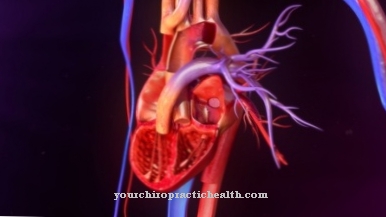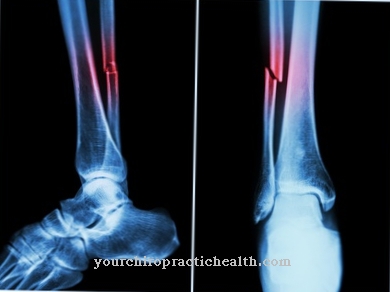The Breathing rest exists when the opposing retraction forces of the thorax and lungs reach equilibrium and compliance or extensibility of the lungs is highest. When breathing is at rest, the lungs only contain their functional residual volume. If the lungs are over-inflated, the breathing position changes in a pathological way.
What is the breath rest position?

The elastic restoring force of the lungs is called retraction force. There are interstitial elastic fibers in the organ. In addition, the alveoli of the lungs have a certain surface tension. Each of the individual, water-lined alveoli strives to shrink, since water molecules exert a certain force of attraction on one another at the interfaces between air and water. For this reason, the lungs are ideally elastic.
After stretching during inspiration (inhalation), the lungs automatically retract to their original size and thus return to the so-called expiratory position. The muscles for expiration (exhalation) remain unused during resting breathing and are only used when the reserve volume is forced to vent. The retraction of the lungs is slowed down by surfactant, which reduces the surface tension of the alveoli by a factor of ten and prevents the lungs from collapsing.
When inhaling, the inspiratory muscles actively overcome the resistance of the lung and thoracic retraction force. The retraction forces of the lungs and thorax are only released again during expiration in the sense of relaxation of the respiratory muscles, so that expiration from the breathing position takes place as a passive process. In this context, the breathing position corresponds to the equilibrium between passive retraction forces of the thorax and lungs, which is automatically established at the end of expiration with normal breathing.
Function & task
In the resting position, the lungs want to regain a smaller volume due to the surface tension of the alveoli and the elasticity of their fibers. The retraction forces of the thorax counteract this. You are trying to expand the thorax. Lung extensibility or lung compliance reaches a maximum in the state of resting breathing.
Lung extensibility is a physical quantity that summarizes the elastic properties of the lungs. The extensibility corresponds essentially to the ratio of the change in volume to the corresponding change in pressure.
Resilient bodies such as inflated balloons are a suitable illustrative example. Such a balloon has a defined volume and a pressure based on it. As more air is added to the balloon, it changes volume and an increase in pressure occurs. The greater the extensibility, the lower the pressure increase with a certain filling volume.
In the respiratory tract, the change in volume corresponds to the so-called tidal volume. Lung extensibility is indirectly proportional to elastic lung retraction pressure. Thus, high compliance only requires low pressure so that the lungs can continue to be filled. In contrast, if compliance is low, more pressure is required to fill the lungs. The highest level of compliance is given when breathing is at rest. This means that the least amount of pressure is required to fill the lungs.
When breathing is at rest, the lungs only contain their functional residual capacity. This functional residual capacity corresponds to the volume of gas that remains in the lungs after normal expiration in the resting phase. The capacity is the sum of the residual volume and the expiratory reserve volume. The functional residual capacity therefore corresponds to the end-expiratory lung volume.
The efforts of the thorax to expand in the resting position are exactly as high as the efforts of the lungs to contract. For this reason, when breathing is resting, neither passive expiration nor active inspiration takes place.
You can find your medication here
➔ Medication for shortness of breath and lung problemsIllnesses & ailments
In the case of chronic overinflation of the lungs, the breathing position is pathologically changed. In late stages, overinflation can lead to chronic airway obstruction and is usually caused by chronic endo- or exobronchial flow obstructions during expiration.
If the expiration is incomplete, the breathing rest position of the inspiratory reserve volume shifts to higher volumes. The breathing rest position shifts to the inspiratory reserve volume of the lungs as soon as the expiration is no longer carried out completely. These processes cause the vital capacity of the lungs to decrease while the functional residual volume increases. The pulmonologist understands the vital capacity as the lung volume between maximum inhalation in the sense of maximum inspiration and maximum exhalation in the sense of expiration.
The parenchyma of the lungs loses elasticity in the event of overinflation and the alveoli have only reduced retraction force. This results in the permanent increase in size of the lungs, which causes a significant loss of performance, is associated with shortness of breath and often weakens the respiratory muscles.
With all obstructive airway diseases there is a strong impairment of the expiratory air flow, while the inspiratory air flow is less impaired. With these diseases, therefore, more air automatically remains in the lungs at the end of expiration, so that acute pulmonary overinflation can occur, especially on the basis of such diseases. Since chronic overinflation of the lungs is accompanied by the structural changes described above, chronic overinflation can develop into irreversible emphysema.
Pneumology differentiates between two different forms of lung hyperinflation. "Static" or anatomically fixed hyperinflation is an absolute overinflation and increases the total capacity of the lungs. Relative overinflation is a "dynamic" overinflation, which is also referred to as "air trapping". In this form, the residual volume increases, as described above, at the expense of vital capacity. The affected patients suffer from an increased airflow position after physical exertion.




.jpg)








.jpg)

.jpg)
.jpg)










